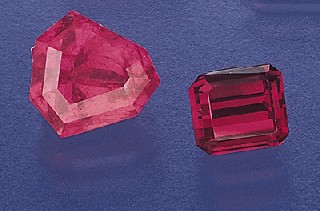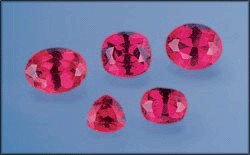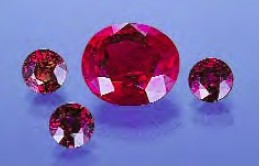Ruby: The Most Valuable Gem
Ruby has been the world's most valued gemstone for thousands of years. In fact, even today, flawless top quality rubies are more valuable and rare than top quality colorless diamonds. A 16 carat ruby sold at auction for US$227,301 per carat at Sotheby's in 1988. A 27.37 carat Burmese ruby ring sold for US$4 million at Sotheby's in Geneva in May 1995, or $146,145 per carat. A 32 carat ruby sold for US$144,000 per carat at Sotheby's in 1989. In contrast, eight D-color internally flawless diamonds over 50 carats were sold in the past 9 years and the largest, a pear-shape of 102 carats, fetched a mere US$125,000 per carat. Top quality untreated rubies are so rare even the world's top gem dealers must incessantly comb estate sales and auctions to find them. Sizes above five carats are particularly rare.
Ruby is the gem quality form of the mineral corundum, and one of the
most durable minerals which exists, a crystalline form of aluminum oxide. Corundum has a
hardness of 9 on the Mohs scale and is also extremely tough. In its common form, corundum
is even used as an abrasive. Colors of Corundum other than red are known as Sapphire.
The element Chromium is responsible for the red color of this gem, but too much
Chromium can actually turn corundum emerald green in color. Heat treatment is very common
in ruby gemstones (as is true for all forms of corundum) and is used to dissolve
"silk" inclusions, which results in a more transparent, more intensely colored
stone. The heat treatment is considered permanent and does not usually detract from the
value of the stone.

The most famous source of fine rubies is Burma, which is now called Myanmar. The ruby mines of Myanmar are older than history: stone age and bronze age mining tools have been found in the mining area of Mogok. Rubies from the legendary mines in Mogok often have a pure red color, which is often described as "pigeon's-blood" although that term is more fanciful than an actual practical standard in the trade today. Myanmar also produces intense pinkish red rubies which are also vivid and extremely beautiful. Many of the rubies from Burma have a strong fluorescence when exposed to ultraviolet rays like those in sunlight, which layers on extra color. Burma rubies have a reputation of holding their vivid color under all lighting conditions.
Since demand for fine rubies is really only limited by the tiny supply available, new sources are always treated as exciting news in the trade. An important mining area in Burma is called Mong Hsu. The Mong Hsu ruby deposit is producing commercial quantities of commercial quality Burma ruby and also significant quantities of fine quality Burma ruby, particularly in sizes up to a carat. Burma ruby is now more readily available than Thai ruby, due to the new ruby rush in the area.
The new deposit has also affected the world capital of the ruby business: Thailand. Many of the ruby traders and cutters from Chanthaburi and Bo Rai have moved to Mae Sai in Thailand. In Tachilek in Myanmar, across the border from Mae Sai, a flourishing trade in Mong Hsu ruby has transformed a village into a prosperous town. Most Mong Hsu ruby is cut and marketed in Thailand, the world's most important ruby trading center. Perhaps 80 percent of the world's ruby goes through Thailand at some point in the trading cycle. The largest ruby cutting factories are in the Chanthaburi area of Thailand. Bangkok is generally where the world's buyers come to purchase ruby.
In 1992, a new ruby mine was discovered in Vietnam that produces rubies which are very similar to rubies from Burma. In fact, the geology of the new mine may be a continuation of the same formation that produced the Burma deposits. Some of the new Vietnamese rubies have been praised by experts as being virtually indistinguishable from top quality Burmese stones.
Fine rubies are also found in Thailand. Thai rubies tend to be darker red in tone: a real red, tending toward burgundy rather than pink, as Burma rubies do. This makes them very popular in the United States where consumers generally prefer their rubies to be a darker red rather than a darker pink. Some Thai rubies have black reflections, a phenomenon called extinction, which can make their color look darker than it really is. But Thai rubies can also have a rich vivid red that rivals the Burmese in intensity. Sri Lankan rubies can also be very beautiful. Many Sri Lankan stones are often pinkish in hue and many are pastel in tone. Some, however, resemble the vivid pinkish red hues from Burma.
Rubies from Kenya and Tanzania surprised the world when they were discovered in the sixties because their color rivals the world's best. Unfortunately, most of the ruby production from these countries has many inclusions, tiny flaws which diminish transparency. Rubies from the African mines are rarely transparent enough to facet. However, their fantastic color is displayed to full advantage when cut cabochon style. A few rare clean stones have been seen which are top quality.
Occasionally a few fine top-quality rubies appear on the market from
Afghanistan, Pakistan, or the Pamir Mountains of the Commonwealth of Independent States.
The terrain in these areas has made exploration for gemstones very difficult but someday
they may produce significant quantities for the world market.


CHOOSING A RUBY
The word red is derived from the Latin for ruby, ruber, which is derived from similar words in Persian, Hebrew, and Sanskrit. The intensity of color of a fine ruby is like a glowing coal, probably the most intensely colored substance our ancestors ever saw. It is no wonder they ascribed magical powers to these fires that burned perpetually and never extinguished themselves.
After color, the other factors which influence the value of a ruby
are clarity, cut, and size. Rubies that are perfectly transparent, with no tiny flaws, are
more valuable than those with inclusions which are visible to the eye. Cut can make a big
difference in how attractive and lively a ruby appears to the eye. A well-cut stone should
reflect back light evenly across the surface without a dark or washed-out area in the
center that can result from a stone that is too deep or shallow. The shape should also be
symmetrical and there should not be any nicks or scratches in the polish.
Ruby sometimes displays a three-ray, six-point star. These star rubies are cut in a smooth
domed cabochon cut to display the effect. The star is best visible when illuminated with a
single light source: it moves across the stone as the light moves. This effect, called
asterism, is caused by light reflecting off tiny rutile needles, called "silk,"
which are oriented along the crystal faces. The value of star rubies and sapphires are
influenced by two things: the intensity and attractiveness of the body color and the
strength and sharpness of the star. All six legs should be straight and equally prominent.
Star rubies rarely have the combination of a fine translucent or transparent color and a
sharp prominent star. These gems are valuable and expensive.
